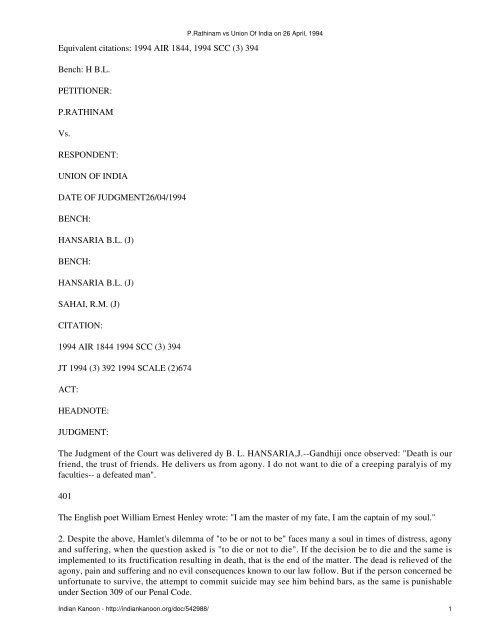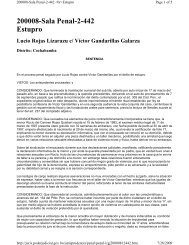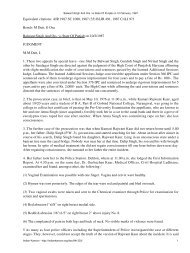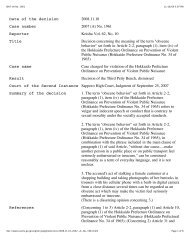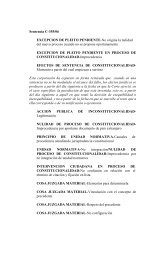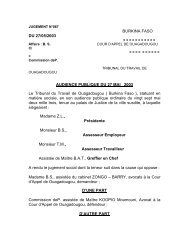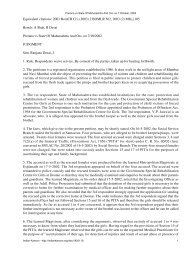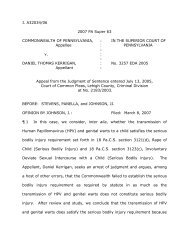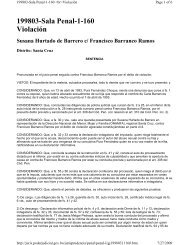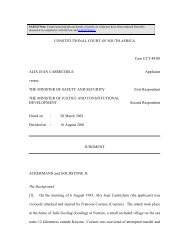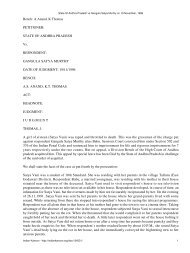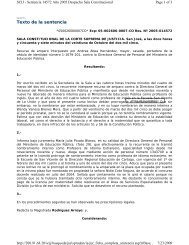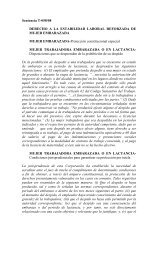P. Rathinam v. Union of India - Cornell University
P. Rathinam v. Union of India - Cornell University
P. Rathinam v. Union of India - Cornell University
- No tags were found...
You also want an ePaper? Increase the reach of your titles
YUMPU automatically turns print PDFs into web optimized ePapers that Google loves.
<strong>of</strong> misery and the accused also belonged to poorer section which added further insult to the injury, would beabuse <strong>of</strong> the process <strong>of</strong> the court. Being <strong>of</strong> this view, each <strong>of</strong> the accused was directed to be acquitted.9. Striking down <strong>of</strong> the section by the Bombay High Court has come to be criticised by the aforesaid ShriPande and Shri Mustafa, so also by Shri D.C. Pande, Research Pr<strong>of</strong>essor, <strong>India</strong>n Law Institute, in his articleon "Criminal Law" [<strong>of</strong> Annual Survey <strong>of</strong> <strong>India</strong>n Law, Vol. 23 (1987) at pp. 260 to 270 <strong>of</strong> published by the<strong>India</strong>n Law Institute]. In the 'Editorial Note' titled 'Taking One's Life' [(1986-87) 91 CWN (Journal Section) atpp. 37 to 40] the Bombay decision received some criticism.10. Before dealing with the points raised in these writings, it would be worthwhile to note that Shri V.S.Deshpande after his retirement as Chief Justice <strong>of</strong> Delhi High Court had expressed his view on this question inhis 1 1987 Cri LJ 743 (1986) 88 Bom LR 589: 1986 Mah LJ 913 (Bom)3 1988 Cri LJ 549 (1987) 2 Andh LJ 263 : 1987 APLJ (Cri) 110 (AP)4 Registered as Cri. Revision No. 230 <strong>of</strong> 1985 403P.<strong>Rathinam</strong> vs <strong>Union</strong> Of <strong>India</strong> on 26 April, 1994article titled "To be or not to be" [(1984) 3 SCC (Journal) at pp. 10 to 15] Shri Deshpande, after referring towhat had been held by this Court regarding the scope <strong>of</strong> Article 21, took the view that if Section 309 isrestricted in its application to attempts to commit suicide which are cowardly and which are unworthy, thenonly this section would be in consonance with Article 21, because, if a person having had no duties to performto himself or to others when he is terminally ill, decides to end his life and relieve himself from the pain <strong>of</strong>living and the others from the burden <strong>of</strong> looking after him, prosecution <strong>of</strong> such a person would be addinginsult to injury and it was asked : "Should a Court construe Section 309 IPC to apply to such cases?"11. Sometime afterwards appeared an article <strong>of</strong> Justice R.A. Jahagirdar <strong>of</strong> Bombay High Court in theIllustrated Weekly <strong>of</strong> <strong>India</strong> (September 29, 1985) in which the learned Judge took the view that Section 309was unconstitutional for four reasons: (1) neither academicians nor jurists are agreed on what constitutessuicide, much less attempted suicide; (2) mens rea, without which no <strong>of</strong>fence can be sustained, is not clearlydiscernible in such acts; (3) temporary insanity is the ultimate reason <strong>of</strong> such acts which is a valid defenceeven in homicides; and (4) individuals driven to suicide require psychiatric care.12. Apart from the aforesaid judicial and legal thinking on the subject relating to justification andpermissibility <strong>of</strong> punishing a man for attempting to commit suicide, there are proponents <strong>of</strong> the view thateuthanasia (mercykilling) should be permitted by law. We do not propose to refer to the thinking on thissubject, principally because the same is beyond the scope <strong>of</strong> the present petitions and also because ineuthanasia a third person is either actively or passively involved about whom it may be said that he aids orabets the killing <strong>of</strong> another person. We propose to make a distinction between an attempt <strong>of</strong> a person to takehis life and action <strong>of</strong> some others to bring to an end the life <strong>of</strong> a third person. Such a distinction can be madeon principle and is conceptually permissible.13. Though what we propose to decide in these cases would, therefore, relate to the <strong>of</strong>fence <strong>of</strong> attemptedsuicide, it is nonetheless required to be stated that euthanasia is not much unrelated to the act <strong>of</strong> committingsuicide inasmuch as wherever passive euthanasia has been held to be permissible under the law, one <strong>of</strong> therequirements insisted upon is consent <strong>of</strong> the patient or <strong>of</strong> his relations in case the patient be not in a position togive voluntary consent. The relationship between suicide and euthanasia has come to be highlighted in adecision <strong>of</strong> the Supreme Court <strong>of</strong> Nevada (one <strong>of</strong> the States <strong>of</strong> United States <strong>of</strong> America) in Mckay v.Bergstedt5 where a patient filed a petition to the court for permitting disconnection <strong>of</strong> his respirator. Thedistrict court, on the facts <strong>of</strong> the case, granted permission. The State appealed to the Supreme Court <strong>of</strong> Nevadawhich, after balancing the interest <strong>of</strong> the patient against the relevant State interest, affirmed the district court'sjudgment. The court took the view that the desire <strong>of</strong> the patient for 404<strong>India</strong>n Kanoon - http://indiankanoon.org/doc/542988/ 3
withdrawal <strong>of</strong> his respirator did not tantamount to suicide the same was rather an exercise <strong>of</strong> his constitutionaland common law right to discontinue unwanted medical treatment. This was the view taken by the majority.One <strong>of</strong> the Judges expressed a dissenting view.14. A comment has been made on the aforesaid decision [at pp. 829 to 838 <strong>of</strong> Suffolk <strong>University</strong> Law Review,Vol. 25 (1991)] by stating that the distinction made by the majority between suicide and euthanasia because <strong>of</strong>differences in motive and mental attitude, is not tenable and the commentator referred to the dissentingopinion in which it was observed that the patient was in fact requesting the court to sanction affirmative actwhich was entirely consistent with the court's definition <strong>of</strong> suicide, inasmuch as the majority had definedsuicide as "an act or instance <strong>of</strong> taking one's own life voluntarily and intentionally; the deliberate andintentional destruction <strong>of</strong> his own life by a person <strong>of</strong> years <strong>of</strong> discretion and <strong>of</strong> sound mind; one that commitsor attempts his self-murder". (This was indeed the definition given in Webster's Third New InternationalDictionary, 1968.)15. We may now note the reasons given by the Bombay High Court in Shripati case2 for striking down thesection as violation <strong>of</strong> Article 21. These reasons are basically three: (1) Article 21 has conferred a positiveright to live which carries with it the negative right not to live. In this connection it has been first stated thatthe fundamental rights are to be read together as held in R. C. Cooper v. <strong>Union</strong> <strong>of</strong> <strong>India</strong>6. Mention was thenmade <strong>of</strong> freedom <strong>of</strong> speech and expression, as to which it was observed that the same includes freedom not tospeak and to remain silent. Similarly, about the freedom <strong>of</strong> business and occupation, it was stated that itincludes freedom not to do business. (2) Notice was then taken <strong>of</strong> the various causes which lead people tocommit suicide. These being mental diseases and imbalances, unbearable physical ailments, affliction bysocially-dreaded diseases, decrepit physical condition disabling the person from taking normal care <strong>of</strong> hisbody and performing the normal chores, the loss <strong>of</strong> all senses or <strong>of</strong> desire for the pleasures <strong>of</strong> any <strong>of</strong> thesenses, extremely cruel or unbearable conditions <strong>of</strong> life making it painful to live, a sense <strong>of</strong> shame or disgraceor a need to defend one's honour or a sheer loss <strong>of</strong> interest in life or disenchantment with it, or a sense <strong>of</strong>fulfilment <strong>of</strong> the purpose for which one was born with nothing more left to do or to be achieved and a genuineurge to quit the world at the proper moment. (3) The Bench thereafter stated that in our country differentforms <strong>of</strong> suicide are known. These being: Johars (mass suicides or self-immolation) <strong>of</strong> ladies from the royalhouses to avoid being dishonoured by the enemies; Sati (self-immolation by the widow on the burning pyre <strong>of</strong>her deceased husband); Samadhi (termination <strong>of</strong> one's life by self-restraint on breathing); Prayopaveshan(starving unto death); and Atmarpana (self-sacrifice). It was also observed that the saints and savants, social,political and religious leaders have immolated themselves in the past and do so even today by one method orthe other and society has not only6 (1970) 2 SCC 298 : AIR 1970 SC 1318405P.<strong>Rathinam</strong> vs <strong>Union</strong> Of <strong>India</strong> on 26 April, 1994not disapproved <strong>of</strong> the practice but has eulogised and commemorated the practitioners. It may be pointed outthat the Bench made a distinction between "suicide" and "mercy- killing"; so also, between suicide and aidingor abetting the same.16. The Bombay High Court held Section 309 as violation <strong>of</strong> Article 14 also mainly because <strong>of</strong> two reasons.First, which act or acts in series <strong>of</strong> acts will constitute attempt to suicide, where to draw the line, is not knownsome attempts may be serious while others non-serious. It was stated that in fact philosophers, moralists andsociologists were not agreed upon what constituted suicide. The want <strong>of</strong> plausible definition or evenguidelines, made Section 309 arbitrary as per the learned Judges. Another reason given was that Section 309treats all attempts to commit suicide by the same measure without referring to the circumstances in whichattempts are made.<strong>India</strong>n Kanoon - http://indiankanoon.org/doc/542988/ 4
17. The first <strong>of</strong> the aforesaid reasons is not sound, according to us,because whatever differences there may beas to what constitutes suicide,there is no doubt that suicide is intentional taking <strong>of</strong> one's life, as stated at p.1521 <strong>of</strong> Encyclopaedia <strong>of</strong> Crime and Justice, Vol. IV, 1983 Edn. Of course, there still exists difference amongsuicide researchers as to what constitutes suicidal behaviour, for example, whether narcotic addiction, chronicalcoholism, heavy cigarette smoking, reckless driving, other risk-taking behaviours are suicidal or not. It mayalso be that different methods are adopted for committing suicide, for example, use <strong>of</strong> firearms, poisoningespecially by drugs, overdoses, hanging, inhalation <strong>of</strong> gas. Even so, suicide is capable <strong>of</strong> a broad definition, ashas been given in the aforesaid Webster's Dictionary. Further, on a prosecution being launched it is alwaysopen to an accused to take the plea that his act did not constitute suicide whereupon the court would decidethis aspect also.18. Ins<strong>of</strong>ar as treating <strong>of</strong> different attempts to commit suicide by the same measure is concerned, the samealso cannot be regarded as violative <strong>of</strong> Article 14, inasmuch as the nature, gravity and extent <strong>of</strong> attempt maybe taken care <strong>of</strong> by tailoring the sentence appropriately. It is worth pointing out that Section 309 has onlyprovided the maximum sentence which is up to one year. It provides for imposition <strong>of</strong> fine only as apunishment. It is this aspect which weighed with the Division Bench <strong>of</strong> Andhra Pradesh High Court in itsaforesaid decision to disagree with the Bombay view by stating that in certain cases even Probation <strong>of</strong>Offenders Act can be pressed into service, whose Section 12 enables the court to ensure that no stigma ordisqualification is attached to such a person. (See para 32 <strong>of</strong> the judgment.)19. We agree with the view taken by the Andhra Pradesh High Court as regards Section 309 qua Article 14.But the Bombay Bench itself was more involved with Article 21 and violation <strong>of</strong> it by Section 309, thereasons where<strong>of</strong> have been noted. Whether these are sound and tenable, would be our real consideration.20. The Bombay High Court's decision2 led some thinkers to express their own views. We have noted whothey were. The broad points <strong>of</strong> their406P.<strong>Rathinam</strong> vs <strong>Union</strong> Of <strong>India</strong> on 26 April, 1994objection/criticism were these: (1) suicide is an act against religion; (2) it is immoral; (3) it produces adversesociological effects; (4) it is against public policy (This has also been the main argument <strong>of</strong> the counsel <strong>of</strong><strong>Union</strong> <strong>of</strong> <strong>India</strong> before us.); (5) it damages monopolistic power <strong>of</strong> the State, as State alone can take life; and (6)it would encourage aiding and abetting <strong>of</strong> suicide and may even lead to 'constitutional cannibalism'.21. We shall in due course see whether the aforesaid objections raisedagainst the Bombay judgment are valid. Concerned as we are with the broad contention that Section 309 isviolative <strong>of</strong> Article 21, we shall first inform ourselves as to the content and reach <strong>of</strong> this article and thenanswer in a general way as to whether a person residing in <strong>India</strong> has a right to die. Section 309 being a part <strong>of</strong>our enacted law, we would desire to know what object a law seeks to achieve. This section having madeattempt to commit suicide an <strong>of</strong>fence, we shall ask the question as to why is a particular act treated as crimeand what acts are so treated. We shall then apply our mind to the purposeful query as to how a crime can beprevented. Being seized with the crime <strong>of</strong> 'attempted suicide', we shall apprise ourselves as to why suicidesare committed and how can they be really prevented. We would also desire to know what type <strong>of</strong> persons havebeen committing suicides and what had been their motivations. We would then view the act <strong>of</strong> committingsuicide in the background <strong>of</strong> our accepted social ethos. Having done so, we shall take up the points <strong>of</strong>criticism noted above one by one and express our views on the same.22. Having known that the Law Commission <strong>of</strong> <strong>India</strong> had in its 42nd Report <strong>of</strong> 1971 recommended deletion<strong>of</strong> Section 309, we shall put on record as to why was this recommendation made and how was the sameviewed by the Central Government; and what steps, if any, were taken by it to implement therecommendation. What is the present thinking <strong>of</strong> the <strong>Union</strong> <strong>of</strong> <strong>India</strong> shall also be taken note <strong>of</strong>.<strong>India</strong>n Kanoon - http://indiankanoon.org/doc/542988/ 5
23. Finally, we shall open our mental window a little to allow breeze to come from other parts <strong>of</strong> the world,inter alia, because Gurudev (Rabindranath Tagore, the Nobel Laureate) wanted us to do so. Globalisation has,in any case, been accepted by us in some other fields <strong>of</strong> our activities. We have stated opening <strong>of</strong> this window"a little" because we propose to confine ourselves to know whether attempt to commit suicide is presently acrime only in two other countries <strong>of</strong> the globe they being United Kingdom and United States <strong>of</strong> America. Thereasons for our selecting these two countries shall be indicated when we shall advert to our 'global view'query. It may only be stated here that we are opening the window only a little, as, the little air that would passthrough the little aperture would be enough, in our view, to enable us to have broad knowledge <strong>of</strong> global viewon the subject under consideration.24. The aforesaid mental odyssey would take us through a long path before we would reach our destination,our conclusion. Finale would, however, come after we have answered or known the following:407(1) Has Article 21 any positive content or is it merely negative in its reach?(2) Has a person residing in <strong>India</strong> a right to die?(3) Why is a law enacted? What object(s) it seeks to achieve?(4) Why is a particular act treated as crime/What acts are so treated?(5) How can crimes be prevented?(6) Why is suicide committed?(7) Who commits suicide? Secularisation <strong>of</strong> suicide.(8) How suicide-prone persons should be dealt with?(9) Is suicide a non-religious act?(10) Is suicide immoral?(11) Does suicide produce adverse sociological effects?(12) Is suicide against public policy?P.<strong>Rathinam</strong> vs <strong>Union</strong> Of <strong>India</strong> on 26 April, 1994(13) Does commission <strong>of</strong> suicide damage the monopolistic power <strong>of</strong> the State to take life? (14) Isapprehension <strong>of</strong> 'constitutional cannibalism' justified?(15) Recommendation <strong>of</strong> the Law Commission <strong>of</strong> <strong>India</strong> and follow-up steps taken, if any.(16) Global view. What is the legal position in other leading countries <strong>of</strong> the world regarding the matter athand?25. The aforesaid questions, which have been framed keeping in mind the information we thought necessaryto enable us to decide the important matter at hand to our satisfaction, have been listed as above keeping inview their comparative importance for our purpose the most important being he first and so on; and wepropose to answer them in the same sequence.<strong>India</strong>n Kanoon - http://indiankanoon.org/doc/542988/ 6
(1) Has Article 21 any positive content or is it merely negative in its reach?26. This question is no longer res integra inasmuch as a Constitution Bench <strong>of</strong> this Court in Unnikrishnan v.State <strong>of</strong> A.p.7 [in which right to receive education up to the primary stage has been held to be a call <strong>of</strong> Article1] has virtually answered this question. This would be apparent from what was stated by Mohan, J. inparagraph 19 and by Jeevan Reddy, J. in paragraph 170. In paragraph 30, Mohan, J. has mentioned about therights which have been held to be covered under Article 21. These being:(1) The right to go abroad. Satwant Singh Sawhney v. D. Ramarathnam APO, New Delhi8. . (2) The right toprivacy. Gobind v. State <strong>of</strong> M.P.9 In this case reliance was placed on the American decision in Griswold v.Connecticut10.7 (1993) 1 SCC 6458 (1967) 3 SCR 525 AIR 1967 SC 18369 (1975) 2 SCC 148 1975 SCC (Cri) 468: (1975) 3 SCR 94610 381 US 479, 510: 14 L Ed2d 511 (1965) 408(3) The right against solitary confinement. Sunil Batra v. Delhi Admn. 11 (4) The right against bar fetters.Charles Shobraj v. Supdt., Central Jail12.(5) The right to legal aid. M. H. Hoskot v. State <strong>of</strong> Maharashtra' 3.(6) The right to speedy trial. Hussainara Khatoon(1) v. Home Secretary, State <strong>of</strong> Bihar14.(7) The right against handcuffing. Prem Shankar Shukla v. Delhi Admn.15(8) The right against delayed execution. T. V. Vatheeswaran v. State <strong>of</strong>T. N. 16(9) The right against custodial violence. Sheela Barse v. State <strong>of</strong> Maharashtral7. (10) The right against publichanging. A.G. <strong>of</strong> <strong>India</strong> v. Lachma Devil'.(11) Doctor's assistance. Paramanand Katra v. <strong>Union</strong> <strong>of</strong> <strong>India</strong>19.(12) Shelter. Shantistar Builders v. N.K. Totame2O.P.<strong>Rathinam</strong> vs <strong>Union</strong> Of <strong>India</strong> on 26 April, 199427. The aforesaid is enough to state that Article 21 has enough <strong>of</strong> positive content in it. As to why the rightsmentioned above have been held covered by Article 21 need not be gone into, except stating that theoriginating idea in this regard is the view expressed by Field, J. in Munn v. IllinoiS21 in which it was heldthat the term 'life' (as appearing in the 5th and 14th amendments to the United States Constitution) meanssomething more than 'mere animal existence'. This view was accepted by a Constitution Bench <strong>of</strong> this Courtin Sunil Batra v. Delhi Admn.22 (SCC paras 55 and 226 : AIR paras 56 and 226), to which further leaveswere added in Board <strong>of</strong> Trustees <strong>of</strong> the Port <strong>of</strong> Bombay v. Dilipkumar Raghavendranath Nadkami23 (SCCpara 13 : AIR para 13); Vikram Deo Singh Tomar v. State <strong>of</strong> Bihar24 (SCC para 5 : AIR para 5); andRamsharan Autyanuprasi v. <strong>Union</strong> <strong>of</strong> <strong>India</strong>25 (SCC para 13 : AIR para 13). In these decisions it was held thatthe word<strong>India</strong>n Kanoon - http://indiankanoon.org/doc/542988/ 7
Which, according to him, has to be influenced by experience and supported by reason.38. The next important thinker <strong>of</strong> England after Hooker was the famous Francis Bacon (1561-1626). In hisEssays (the most popular <strong>of</strong> his works) we find his views on legislators and legislation. Bacon stood out forprogress and utility and was <strong>of</strong> the view that it was not good to try experiments in legislation. As againstBacon there was Sir Edward Coke, who was a defender <strong>of</strong> the rights <strong>of</strong> the Parliament. Mention is then madeabout John Locke (1632-1704) according to whom the laws made must respect the right to liberty andproperty; and laws must be made for the good <strong>of</strong> the people.39. Ruthnaswamy then takes the reader to France and mentions about Montesquieu (1689-1755), who in hisfamous Spirit <strong>of</strong> Laws published in 1748, which has been regarded as a great classic <strong>of</strong> political and legalliterature, rendered immemorial service to legislation and legislatures. In this monumental work, he insiststhat laws and legislation should be in conformity with the spirit <strong>of</strong> the people, if its traditions, its philosophy<strong>of</strong> life, even the physical surroundings <strong>of</strong> the people, including the climate. The journey is then to Germany,where Leibnitz (1646-1717), a philosopher, mathematician and adviser <strong>of</strong> kings and princes in Germany andEurope, took the view that greatness <strong>of</strong> law is proved by the fact that great rulers were also great law- givers.Names <strong>of</strong> Augustus, Constantine and Justinian are mentioned in this regard. The German philosopher furthersaid that the law must serve morality, because what is against morals is bad law.40. Readers then find themselves in Italy and they are acquainted with Beccaria (1739-1794), who through hispamphlet under the title Delict and Crimes published in 1766 brought a revolution in the theory and practice<strong>of</strong> punishment, because, according to him, punishment <strong>of</strong> crime must be used only for the defence <strong>of</strong> the Stateand the people and not for retribution and revenge which principles were holding the field then.41. As per sequence <strong>of</strong> time, the next writer to be mentioned is Edmund Burke (1727-1797), who was aparliamentarian, statesman and political412P.<strong>Rathinam</strong> vs <strong>Union</strong> Of <strong>India</strong> on 26 April, 1994thinker. According to him the main essential <strong>of</strong> good laws and legislation is that the same should be fit andequitable, so that the legislature has a right to demand obedience. He would say there are two fundamentalprinciples <strong>of</strong> legislation equity and utility.42. Blackstone is a name which is immortal in the world <strong>of</strong> legal jurisprudence. It is his Commentaries on theLaws <strong>of</strong> England (1765) which has made him so. He emphasised on the inviolability <strong>of</strong> common law, freedom<strong>of</strong> persons and property. After Blackstone, came Bentham (17481832) and the Utilitarians.43. Ruthnaswamy has also acquainted the readers about the views <strong>of</strong> Plato, Aristotle, Cicero and ThomasAquinas, so also what Voltaire (16941773) had to say. We do not propose to burden this judgment with theirviews; but what was said by Macaulay (1800-1859) has to be noted, because it is he who had drafted ourPenal Code. Macaulay believed in the efficacy <strong>of</strong> law in improving people and their character. He wrote:"When a good system <strong>of</strong> law and police is established, when justice is administered cheaply and firmly, whenidle technicalities and unreasonable rules <strong>of</strong> evidence no longer obstruct the search for truth, a great change <strong>of</strong>the better may be expected which shall produce a great effect on the national character."44. In Chapter 6 <strong>of</strong> the book, Runthnaswamy has stated that after the principles <strong>of</strong> Benthamism andutilitarianism, reason, utility and individual liberty had exhausted themselves, humanitarianism occupied thefield and it is this principle which has seen the enactments <strong>of</strong> statutes like Workmen's Compensation Act,Factories Act and various other statutes dealing with public health, sanitation and weaker sections.<strong>India</strong>n Kanoon - http://indiankanoon.org/doc/542988/ 10
45. We do not propose to dive further and would close this discussion by referring to what was stated byIhering (1818- 1892) in his "Geist Des Romisches Rechts" (The Spirit <strong>of</strong> Roman Law), which has beenaccepted as a legal classic. According to Ihering, law is a means to an end. He laid down the following generalprinciples <strong>of</strong> legislation: "1. Laws should be known to be obeyed.2. Laws should answer expectations.3. Laws should be consistent with one another.4. Laws should serve the principle <strong>of</strong> Utility.5. Laws should be methodical.6. Laws must be certain to be obeyed, must not become a dead letter.7. Laws are necessary to ward <strong>of</strong>f the danger <strong>of</strong> the operations <strong>of</strong> egoism or self- interest, the ordinary motives<strong>of</strong> human action.8. Law and legislation must aim at justice which is that which suits all.9. Laws are interconnected "laws like human beings lean on one another."413P.<strong>Rathinam</strong> vs <strong>Union</strong> Of <strong>India</strong> on 26 April, 199446. That humanitarianism is the throbbing principle <strong>of</strong> legislation presently has also been highlighted byKartar Singh Mann in his article "Working <strong>of</strong> Legislatures in the matter <strong>of</strong> Legislation" appearing at pp. 491to 495 <strong>of</strong> the Journal <strong>of</strong> Parliamentary Information, Vol. 33, 1987. What has been stated by Mann at p. 493 isrelevant for purpose the same being:"In the historical perspective, one can easily appreciate the complexities and intricacies <strong>of</strong> legislation whichthe present legislatures are to face. Besides the ordinary laws which safeguard the rights and liberties <strong>of</strong> theindividual, there are certain fundamental laws which ordinary legislation may not change. In countries likeFrance, Germany and <strong>India</strong> which are having their written Constitutions their fundamental laws are embodiedthere itself. The fundamental principles on which the political life <strong>of</strong> the people is based are individuality,equality and justice. After securing the life and liberty <strong>of</strong> the State and <strong>of</strong> the individual, laws and legislationstake on the task <strong>of</strong> serving and promoting the good life <strong>of</strong> the State and the people. For good life, morality isnecessary and to maintain morality legislation is a must. Legislation is the framework which is required to bemade for good life."47. What was opined by Ian Temy, Q.C., Director <strong>of</strong> Public Prosecution in his article "Euthanasia Is itmurder?" [as printed at pp. 2 to 7 <strong>of</strong> Australian Journal <strong>of</strong> Forensic Sciences, Vol. 21 (1), September 1988] isalso relevant for our purpose. That article was concluded at p. 7 in these words:"I have necessarily spoken about the law as it is. There is nothing immutable about it. To the extent it does notmeet social needs and a strong consensus emerges to that effect, the law can and should be changed......48. The aforesaid show that law has many promises to keep including granting <strong>of</strong> so much <strong>of</strong> liberty as wouldnot jeopardise the interest <strong>of</strong> another or would affect him adversely, i.e., allowing <strong>of</strong> stretching <strong>of</strong> arm up tothat point where the other fellow's nose does not begin. For this purpose, law may have "miles to go". Then,law cannot be cruel, which it would be because <strong>of</strong> what is being stated later, if persons attempting suicide aretreated as criminals and are prosecuted to get them punished, whereas what they need is psychiatric treatment,because suicide basically is a "call for help", as stated by Dr (Mrs) Dastoor, a Bombay Psychiatrist, who heads<strong>India</strong>n Kanoon - http://indiankanoon.org/doc/542988/ 11
an Organisation called "Suicide Prevent". May it be reminded that a law which is cruel violates Article 21 <strong>of</strong>the Constitution, a la, Deena v. <strong>Union</strong> <strong>of</strong> <strong>India</strong>29. (4) Why is a particular act treated as crime? What acts areso treated?49. Earliest reference to the word "crime" dates back to 14th century when it conveyed to the mind somethingreprehensible, wicked or base. Any conduct which a sufficiently powerful section <strong>of</strong> any given communityfeels 29 (1983) 4 SCC 645 : 1983 SCC (Cri) 879: AIR 1983 SC 1155 414to be destructive <strong>of</strong> its own interest, as endangering its safety, stability or comfort is usually regarded asheinous and it is sought to be repressed with severity and the sovereign power is utilised to prevent themischief or to punish anyone who is guilty <strong>of</strong> it. Very <strong>of</strong>ten crimes are creations <strong>of</strong> government policies andthe Government in power forbids a man to bring about results which are against its policies.50. In a way there is no distinction between crime and tort, inasmuch as a tort harms an individual whereas acrime is supposed to harm a society. But then, a society is made <strong>of</strong> individuals, harm to an individual isultimately harm to society.51. A crime presents these characteristics: (1) it is a harm, brought about by human conduct which thesovereign power in the State desires to prevent;(2) among the measures <strong>of</strong> prevention selected is the threat <strong>of</strong> punishment; and (3) legal proceedings <strong>of</strong> aspecial kind are employed to decide whether the person accused did in fact cause the harm, and is, accordingto law, to be held legally punishable for doing so. (See pp. 1 to 5 <strong>of</strong> Kenny's Outlines <strong>of</strong> Criminal Law, 19thEdn., for the above propositions.)52. Protection <strong>of</strong> society is the basic reason <strong>of</strong> treating some acts as crime. Indeed it is one <strong>of</strong> the aims <strong>of</strong>punishment. Where there is no feeling <strong>of</strong> security, there is no true freedom. What is the effect <strong>of</strong> the samecannot be described better than what was stated by Hobbes in Leviathan, which is:"There is no place for industry, because the fruit there<strong>of</strong> is uncertain; and consequently no culture <strong>of</strong> the earth;no navigation nor use <strong>of</strong> the commodities that may be imported by sea; no commodious building; noinstrument <strong>of</strong> moving and removing such things as require much forces; no knowledge <strong>of</strong> the face <strong>of</strong> the earth;no account <strong>of</strong> time; no arts, no letters; no society; and which is worst <strong>of</strong> all continual fear and danger <strong>of</strong>violent death; and the life <strong>of</strong> a solitary, poor, nasty, brutish and short."53. As constitutionality <strong>of</strong> Section 309 has been assailed as being violative <strong>of</strong> Article 21 which protects lifeand personal liberty, it would be in fitness <strong>of</strong> things to note what J.S. Mill had to say about making an actrelatable to personal liberty punishable. This is what Mill had said in this connection in his famous tract OnLiberty : "The object <strong>of</strong> this Essay is to assert one very simple principle, as entitled to govern absolutely thedealings <strong>of</strong> society with the individual in the way <strong>of</strong> compulsion and control, whether the means used bephysical force in the form <strong>of</strong> legal penalties or the moral coercion <strong>of</strong> public opinion. That principle is that thesole end for which mankind are warranted individually or collectively, in interfering with the liberty <strong>of</strong> action<strong>of</strong> any <strong>of</strong> their number, is self- protection. That the only purpose for which power can be rightfully exercisedover any member <strong>of</strong> a civilised community, against his will, is to prevent harm to others. His own good, eitherphysical or moral, is not a sufficient warrant. He cannot rightfully be compelled to do or forbear because itwill be better for him to do so, because it will make him happier, because, in the opinions <strong>of</strong>415P.<strong>Rathinam</strong> vs <strong>Union</strong> Of <strong>India</strong> on 26 April, 1994others to do so would be wise, or even right. These are good reasons for remonstrating with him or reasoningwith him, or persuading him, or entreating him, but not for compelling him, or visiting him with any evil incase he does otherwise. To justify that, the conduct from which it is desired to deter him must be calculated to<strong>India</strong>n Kanoon - http://indiankanoon.org/doc/542988/ 12
produce evil to someone else. The only part <strong>of</strong> the conduct <strong>of</strong> anyone, for which he is amenable to society isthat which concerns others. In the part which merely concerns himself, his independence is, <strong>of</strong> right, absolute.Over himself, over his own body and mind, the individual is sovereign." (emphasis supplied)54. The very definition <strong>of</strong> 'crime' depends on the values <strong>of</strong> a given society. To establish this what has beenstated by Justice Krishna Iyer in his book Perspectives in Criminology, Law and Social Change (1980) at pp.7 and 8 may be noted:"What is a sex crime in <strong>India</strong> may be sweetheart virtue in Scandinavia. What is an <strong>of</strong>fence against property ina capitalist society may be a lawful way <strong>of</strong> life in a socialist society. What is permissible in an affluenteconomy may be a pernicious vice in an indigent community. Thus, criminologists must have their feet all thetime on terra firma."55. Not only this, crimes can also be created or abolished with the passage <strong>of</strong> time, as stated at p. 7 <strong>of</strong> R.S.Cavan's Criminology (2nd Edn.). This has been elucidated by the author by stating that in democracy whereindividual opinion can express itself freely through speaking, writing and elections, public opinion becomesthe final arbiter in placing the opprobrium <strong>of</strong> crime upon a specific type <strong>of</strong> behaviour and when a law is notaccepted the police may attempt to enforce it against public opinion, but gradually the police yield to thepressure <strong>of</strong> public opinion, which they perhaps share. The law may remain on the statute books but be ignoredby all. Whereas when the public opinion supports the law, many pressures <strong>of</strong> an informal nature are broughtagainst the violators to aid and lessen the police action.(5) How can crimes be prevented ?56. The aforesaid subject is too wide and cannot be discussed meaningfully within the parameters available tous in this judgment. The treatise on Crime and its Prevention edited by Stephen Lewin, Editor, World WeekMagazine, would show how complicated the subject is. At p. 217 <strong>of</strong> the 3rd printing (1973) mention has beenmade about seven steps for combating a crime. We may not go into the details. Sufficient to say that the stepsrelate to different disciplines.57. Pr<strong>of</strong>essor Dr N.V. Paranjape, Pr<strong>of</strong>essor and Head <strong>of</strong> the Department <strong>of</strong> Postgraduate and Research in Lawand Dean Faculty <strong>of</strong> Law, Jabalpur <strong>University</strong>, in his book Criminiology and Penology has something to sayin Chapter VI about causes <strong>of</strong> crime, knowledge <strong>of</strong> which is necessary to combat and prevent the same. DrParanjape states that in the absence <strong>of</strong> a single theory <strong>of</strong> crime-causation, criminologists have <strong>of</strong>fered differentexplanations to justify their own theory as an explanation <strong>of</strong> delinquent behaviour. There are, however, somewriters who seem to be convinced that416P.<strong>Rathinam</strong> vs <strong>Union</strong> Of <strong>India</strong> on 26 April, 1994no single theory <strong>of</strong> crime can fully explain the causes <strong>of</strong> crime. They therefore prefer a multiple approach tocriminal behaviour which suggests that crime is generated not as a result <strong>of</strong> one solitary factor but as aconsequence <strong>of</strong> a combination <strong>of</strong> such factors.58. Justice Krishna lyer also in his aforesaid book has dealt with this aspect in Chapter 2 captioned "ThePathology <strong>of</strong> <strong>India</strong>n Criminology". In his usual inimitable style, he has painted the crime scenario on a broadcanvas and has mentioned about various factors which lead to commission <strong>of</strong> crimes.59. Reference may also be made to the White Paper presented to the Parliament by Her Majesty's Governmentin 1990 on the subject <strong>of</strong> "Crime, Justice and Protecting the Public", published as Cm. No. 965. The WhitePaper has summarised main proposals as below:<strong>India</strong>n Kanoon - http://indiankanoon.org/doc/542988/ 13
"A coherent legislative framework for sentencing with the severity <strong>of</strong> the punishment matching theseriousness <strong>of</strong> the crime and a sharper distinction in the way the courts deal with violent and non-violentcrimes;New powers for the Crown Court to impose longer sentences for violent and sexual <strong>of</strong>fences, if this isnecessary to protect the public from serious harm;New powers for all courts to combine community service and probation and to impose curfews on <strong>of</strong>fendersso that more <strong>of</strong>fenders convicted <strong>of</strong> property crimes can be punished in the community;Reducing the maximum penalties for theft and burglary, except burglaries <strong>of</strong> people's homes, which can be avery serious matter;Requiring the courts to consider a report by the probation service before giving a custodial sentence and togive reasons for imposing a custodial sentence, except for the most serious <strong>of</strong>fences;Encouraging more use <strong>of</strong> financial penalties, especially compensation to victims and fines which take account<strong>of</strong> <strong>of</strong>fenders' means;Making the time actually served in prison closer to the sentence ordered by the court, replacing the presentsystem <strong>of</strong> remission and parole by new arrangements which ensure that all prisoners serve at least half theirsentences in custody; prisoners serving sentences <strong>of</strong> 4 years or more would not get parole if this would put thepublic at risk; New powers for the courts to return released prisoners to custody up to the end <strong>of</strong> theirsentence, if they are convicted <strong>of</strong> a further imprisonable <strong>of</strong>fence;All prisoners serving sentences <strong>of</strong> a year or more to be supervised by the probation service on release, withnew national standards for supervision;Wider powers for the courts to make parents take more responsibility for crimes committed by their children;417More flexible powers for the courts to deal with 16 and 17 year old <strong>of</strong>fenders;Changing the juvenile courts to youth courts, to deal with defendants under the age <strong>of</strong> 18."60. It would be <strong>of</strong> some interest in this connection to point out that as late as 1991 a need was felt by theBritish Government to issue a Royal Warrant for issuing a commission to examine the effectiveness <strong>of</strong> thecriminal justice in England and Wales in securing the conviction <strong>of</strong> those guilty <strong>of</strong> criminal <strong>of</strong>fences and theacquittal <strong>of</strong> those who were innocent. For this purpose, the Royal Warrant wanted the commission to make itsrecommendation on various aspects <strong>of</strong> the criminal justice. The commission submitted its report in July 1993and it contains recommendations which number 352 and have been mentioned at pp. 188 and 219 <strong>of</strong> theReport issued by Her Majesty's Stationery Office.61. The difficult task <strong>of</strong> crime prevention would not therefore permit the solution to be put into a strait- jacket;it has to be modulated and moulded as per time and clime.Effect <strong>of</strong> PunishmentP.<strong>Rathinam</strong> vs <strong>Union</strong> Of <strong>India</strong> on 26 April, 199462. The aforesaid is not enough for our purpose. We have also to know as to whether infliction <strong>of</strong> punishmentcan be said to have a direct relation with the reduction <strong>of</strong> criminal propensity. It would be enough in thiscontext to state that it has been seriously doubted whether imposition <strong>of</strong> even death sentence has been able to<strong>India</strong>n Kanoon - http://indiankanoon.org/doc/542988/ 14
educe the number <strong>of</strong> murders. Bhagwati, J. as he then was, in his dissenting judgment in the case <strong>of</strong> BachanSingh v. State <strong>of</strong> Punjab30 has brought home well this aspect <strong>of</strong> the matter.63. While on the question <strong>of</strong> sentencing it would be rewarding to note that sentencing has been regarded as asubtle art <strong>of</strong> healing, and the legal and political people uninstructed in the humanist strategy <strong>of</strong> reformation,fail even on first principles. Justice lyer in his aforesaid book has further stated at p. 47 that it puzzles a Judgeor a Home Secretary to be told in Shavian paradox: "If you are to punish a man retributively, you must injurehim. If you are to reform him, you must improve him. And men are not improved by injuries."64. What was said by Victor Hugo in his Les Miserables is instructive: "We shall look upon crime as adisease. Evil will be treated in charity instead <strong>of</strong> anger. The change will be simple and sublime. The crossshall replace the scaffold, reason is on our side, feeling is on our side and experiment is on our side."65. This is not all. It would be wrong to think that a person attempting to commit suicide does not getpunished. He does. The agony undergone by him and the ignominy to be undergone is definitely apunishment, though not a corporal punishment; but then, Section 309 has provided for a sentence30 (1982) 3 SCC 24: 1982 SCC (Cri) 535 : AIR 1982 SC 1325 418<strong>of</strong> fine also. Agony and ignominy undergone would be far more painful and deterrent than a fine which toomay not come to be realised if the person concerned were to be released on probation.(6) Why is suicide committed?66. "Suicide, the intentional taking <strong>of</strong> one's life, has probably been a part <strong>of</strong> human behaviour sincepre-history. Many ancient texts including the Bible, the Koran and the Rig Veda, mention suicide. Because theact <strong>of</strong> self-destruction represents an attack on some <strong>of</strong> our presumptions that life is to be lived and deathfeared responses to suicide have involved a variety <strong>of</strong> emotionally-charged attitudes. These have ranged fromapprobation accorded to it by the ancient Greek stoics to, more typically, the fear and superstitution that led18th century Europeans to drive stakes through the hearts <strong>of</strong> those who had committed suicide."[Encyclopaedia <strong>of</strong> Crime and Justice (1 983), Vol. 4, p. 5 20]The change in social thinking in this regard can be best illustrated by the view taken by the conservativeEnglish society where to start with suicide itself was regarded as a felony requiring burial in a public highway,followed by forfeiture <strong>of</strong> all the properties <strong>of</strong> the deceased to the Crown. Presently, the Suicide Act, 1961 doesnot even regard attempt to suicide as an <strong>of</strong>fence.67. Various social forces like the economy, religion and socioeconomic status are responsible for suicides.There are various theories <strong>of</strong> suicide, to wit, sociological, psychological, biochemical and environmental(Ibid, pp. 1523-24).68. The causes <strong>of</strong> suicides are many and varying inasmuch as some owe their origin to sentiments <strong>of</strong>exasperation, fury, frustration and revolution; some are the result <strong>of</strong> feeling <strong>of</strong> burden, torture, and sadness.Some are caused by loss <strong>of</strong> employment, reversal <strong>of</strong> fortune, misery due to illness, family trouble andthwarted love. Sometimes killing is in opposition to society and sometimes in opposition to particular persons.This happens when the person committing suicide nurses a feeling <strong>of</strong> unjust treatment, maltreatment andcruelty. [See the Causes <strong>of</strong> Suicide by Maurice Halbwacks (translated by Harold Goldblatt).] The Bombayjudgment has mentioned many causes in paragraph 12 <strong>of</strong> its judgment which have been noted in paragraph 15above. The same may not be repeated.(7) Who commits suicide? Secularisation <strong>of</strong> suicide.P.<strong>Rathinam</strong> vs <strong>Union</strong> Of <strong>India</strong> on 26 April, 1994<strong>India</strong>n Kanoon - http://indiankanoon.org/doc/542988/ 15
69. Suicide knows no barriers <strong>of</strong> race, religion, caste, age or sex. In a study undertaken in United States, towhich reference has been made at p. 14 <strong>of</strong> Suicidology: Contemporary Developments by E.S. Scheneidman,(1976), it was found that both Roman Catholics and Protestants were equally susceptible to commission <strong>of</strong>suicide. It is because <strong>of</strong> this that it has been felt in the United States that there is "secularisation <strong>of</strong> suicide". Inour country also Hindus, Muslims, Sikhs, Christians, Buddhists, Jains and Parsis are known to have beencommitting or attempting suicides. Though there has been no particular study as to the religious faith <strong>of</strong> thepersons committing 419suicide or attempting to commit suicide, it can safely be stated that there is "secularisation <strong>of</strong> suicide" in ourcountry also.70. While on the question "Who commits suicide?", it would be relevant to state that there has been greatincrease in the number <strong>of</strong> commission <strong>of</strong> suicides. In his aforementioned article, Shri Faizan Mustafa pointedout that the number <strong>of</strong> suicides by the youths below 18 in 1986 was 7545. But out <strong>of</strong> about 60,000 personswho committed suicide in 1990 nearly half <strong>of</strong> them were aged between 18 to 25, which is generallyconsidered to be the best period <strong>of</strong> a person's life.71. As per the report published in <strong>India</strong>n Express <strong>of</strong> 31-10- 1984, in Ahmedabad city 5 suicide cases hadoccurred during 24 hours immediately preceding 30th October. In a write-up as published in <strong>India</strong> Today <strong>of</strong>15-101984 under the caption "Bangalore: The Suicide City", it has been stated that Bangalore which hadearned the title <strong>of</strong> "Boom City" nearly a year ago, could more appropriately be described as "Doom City" bylast month. The figures collected for the first half <strong>of</strong> the year shocked the members <strong>of</strong> the State Legislaturebecause <strong>of</strong> incredible 664 suicidal deaths over a six-month period, which was higher than the total combinedfigures for Calcutta and Hyderabad in the last three years. (8) How suicide-prone persons should be dealtwith?72. We now come to the question relating to the treatment to be given to the persons who attempt to commitsuicide. Do they deserve prosecution because they had failed? is the all important question. The answer has tobe a bold NO. The reasons are not far to seek. Let us illustrate this first by referring to the case <strong>of</strong> those 20persons who committed suicide in Tamil Nadu distressed as they felt because <strong>of</strong> prolonged illness <strong>of</strong> ChiefMinister, M.G. Ramachandran. That this had happened was published in the <strong>India</strong>n Express <strong>of</strong> 28-10-1984.Question is whether these persons would have deserved prosecution had they failed in their attempt? Theanswer has to be that there can be no justification to prosecute such sacrificers <strong>of</strong> their lives. Similar approachhas to be adopted towards students who jump into wells after having failed in examinations, but survive. Theapproach cannot be different qua those girls/boys who resent arranged marriages and prefer to die, butultimately fail.73. Let us come to the case <strong>of</strong> a woman who commits suicide because she had been raped. Would it not beadding insult to injury, and insult manifold, to require such a woman in case <strong>of</strong> her survival, to face theignominy <strong>of</strong> undergoing an open trial during the course <strong>of</strong> which the sexual violence committed on her whichearlier might have been known only to a few, would become widely known, making the life <strong>of</strong> the victim stillmore intolerable. Is it not cruel to prosecute such a person?74. We would go further and state that attempt to commit suicide by such a woman is not, cannot be, a crime.What is crime in such a case is to prosecute her with a view to get her punished. It is entirely a different matterthat at the end <strong>of</strong> the trial, the court may impose a token fine or even release420P.<strong>Rathinam</strong> vs <strong>Union</strong> Of <strong>India</strong> on 26 April, 1994the convict on probation. That would not take care <strong>of</strong> the mental torture and torment which the woman wouldhave undergone during the course <strong>of</strong> the trial. Such a prosecution is, therefore, par excellence persecution.And why persecute the already tormented woman? Have we become soulless? We think not. What is required<strong>India</strong>n Kanoon - http://indiankanoon.org/doc/542988/ 16
is to reach the soul to stir it to make it cease to be cruel. Let us humanise our laws. It is never late to do so.75. Suicide, as has already been noted, is a psychiatric problem and not a manifestation <strong>of</strong> criminal instinct.We are in agreement with Dr (Mrs) Dastoor that suicide is really a "call for help" to which we shall add thatthere is no "call for punishment" in it. Mention may also be made about what was observed in "The Attitudes<strong>of</strong> Society towards Suicide", a xerox copy <strong>of</strong> which is a part <strong>of</strong> written submissions filed on behalf <strong>of</strong>Respondent 2 (State <strong>of</strong> Orissa) in W.P. No. (Crl.) 419 <strong>of</strong> 1987. It has been stated in this article at p. 9 thatshortly after passing <strong>of</strong> the Suicide Act, 1961 (in England), the Ministry <strong>of</strong> Health issued recommendationadvising all doctors and authorities that attempted suicide was to be regarded as a "medical and socialproblem", as to which it was stated that the same was "more in keeping with present-day knowledge andsentiment than the purely moralistic and punitive reaction expressed in the old law".76. So what is needed to take care <strong>of</strong> suicide-prone persons are s<strong>of</strong>t words and wise counselling (<strong>of</strong> apsychiatrist) and not stony dealing by a jailor following harsh treatment meted out by a heartless prosecutor.(9) Is suicide a non-religious act?77. Every individual enjoys freedom <strong>of</strong> religion under our Constitution, vide Article 25. In a paper which ShriG.P. Tripathi had presented at the World Congress on Law and Medicine held at New Delhi under the caption"Right to die", he stated that every man lives to accomplish four objectives <strong>of</strong> life: (1) Dharma (religion andmoral virtues); (2) Artha (wealth); (3) Kama (love or desire); and (4) Moksha (spiritual enjoyment). All theseobjectives were said to be earthly, whereas others are to be accomplished beyond life. When the earthlyobjectives are complete, religion would require a person not to cling to the body. Shri Tripathi stated that aman has moral right to terminate his life, because death is simply changing the old body into a new one by theprocess known as Kayakalp, a therapy for rejuvenation.78. Ins<strong>of</strong>ar as Christians are concerned, reference may be made to what Pope John Paul 11 stated when hegave his approval to the document issued by the sacred congregation stating:when inevitably death is imminent in spite <strong>of</strong> the means used, it is permitted in conscience to take decision torefuse forms <strong>of</strong> treatment that would only secure precarious and burdensome prolongation <strong>of</strong> life, so long asthe normal care due to sick person in similar cases is not interrupted......79. In the Encyclopaedia <strong>of</strong> Religion, Vol. 8 (1987), mention has been made at pp. 541 to 547 as to how "life"has been understood by different421P.<strong>Rathinam</strong> vs <strong>Union</strong> Of <strong>India</strong> on 26 April, 1994religions. After discussing the subject as understood by the primitive societies, Judaism, Christianity,Hinduism and Buddhism, the discussion has been included by stating that the very act <strong>of</strong> posing the question"What is life?" produces an initial sense <strong>of</strong> bafflement and perplexity. It has been stated thereafter that aprecise, distinct and universally acceptable concept does not accompany the use <strong>of</strong> the word "life"; and thatposing <strong>of</strong> the above query brings in its wake a sense that life is an "inexhaustible storehouse <strong>of</strong> mysteries, arealm <strong>of</strong> endlessly self-perpetuating novelties, in which the solution to any given problem gives rise to aplethora <strong>of</strong> other questions that beckon the always restless, never contended mind <strong>of</strong> Homo Sapiens to seekfurther for additional answers or, at least, to search out more intellectually refined, morally elevating, andspiritually salutary ways <strong>of</strong> pursuing the quest". So, life does not end in this world and the quest continues,may be after the end <strong>of</strong> this life. Therefore, one who takes life may not really be taken to have put an end tohis whole life. There is thus nothing against religion in what he does.80. Ins<strong>of</strong>ar as our country is concerned, mythology says Lord Rama and his brothers took Jalasamadhi in riverSaryu near Ayodhya; ancient history says Buddha and Mahavira achieved death by seeking it; modem history<strong>India</strong>n Kanoon - http://indiankanoon.org/doc/542988/ 17
<strong>of</strong> Independence says about various fasts unto death undertaken by no less a person than Father <strong>of</strong> the Nation,whose spiritual disciple Vinoba Bhave met his end only recently by going on fast, from which act (<strong>of</strong> suicide)even as strong a Prime Minister as Indira Gandhi could not dissuade the Acharya.81. The aforesaid persons were our religious and spiritual leaders; they are eulogised and worshipped. Eventhe allegation against them that they indulged in a non- religious act, would be taken as an act <strong>of</strong> sacrilege. So,where is non-religiosity in the act <strong>of</strong> suicide so far as our social ethos is concerned? And it is this ethos, thissocial mores, which our law has to reflect and respect. (10) Is suicide immoral?82. Law and morals <strong>of</strong>ten intersect and there can be no doubt that historically at least law and morals wereclosely related and that in many areas the law continues to look upon its function as the enforcement <strong>of</strong>morals, the reinforcement <strong>of</strong> moral standards in society, and the punishment <strong>of</strong> moral depravity, as noted at p.19 <strong>of</strong> Burton M. Leiser's Liberty, Justice and Morals (1973). The Constitution <strong>of</strong> United States contains anumber <strong>of</strong> provisions embodying moral judgments, one <strong>of</strong> which is prohibition against 'cruel and unusualpunishment". As to due process clause, it was stated by Justice Frankfurter in Solesbee v. Balkcom31 that it"embodies a system <strong>of</strong> rights based on moral principles ... which comports with the deepest notions <strong>of</strong> what isfair and right and just".83. If, however, the law be unjust would a person not be entitled to Hisobey it? The civil disobediencemovement organised by leaders like Gandhiji shows that there can be clash <strong>of</strong> law and morality, which can beon 94LEd 604:339US9(1949)422the battlefield <strong>of</strong> man's conscience. It is this which agitated the mind <strong>of</strong> Socrates when he was in jail. He wasadvised to escape and was assured that it would be a safe escape. He refused saying that having devoted hislife to teach the importance <strong>of</strong> doing justice and respecting the laws, it would be rank hypocrisy for him toviolate his principles when the laws had been turned against him. Being <strong>of</strong> this view, instead <strong>of</strong> breaking law,he took poison. But then, at times an individual would be between two horns <strong>of</strong> dilemma when confrontedwith the question <strong>of</strong> obeying an unjust and pernicious law. The theories <strong>of</strong> Divine Law and Natural Law wereevolved to take care <strong>of</strong> this dilemma and French Declaration <strong>of</strong> Rights <strong>of</strong> Men and American Declaration <strong>of</strong>Independence are based on these laws.84. In the aforesaid work <strong>of</strong> Burton, this aspect <strong>of</strong> the matter has been concluded at p. 353 by stating as below:"It is right to be law-abiding. But there may be times when it is not wrong to break the law. There are no easyrules or recipes to guide us in making our choices. Some people, who allow themselves to be governed byexpediency and narrow self-interest when they choose to disobey traffic, are indignant when their neighboursviolate laws because their religious and moral convictions do not permit them to do otherwise. Anarchy is aterrible thing. It is all that Hobbes said it was. It is more likely to come from motives like those <strong>of</strong> the speeder,the drunken driver, and the one who cheats on his income tax, rather than from those<strong>of</strong> men like Gandhi, King (meaning Martin Luther King)......(emphasis supplied)P.<strong>Rathinam</strong> vs <strong>Union</strong> Of <strong>India</strong> on 26 April, 199485. Though the question <strong>of</strong> morality normally arises with laws relating to sex and acts evincing moraldepravity like cheating, but as the question <strong>of</strong> birth and death has also moral significance, as opined by MaryWarnock, whose views in this regard have been noted at p. 86 <strong>of</strong> Simon Lee's Laws and Morals (1986), wemay briefly advert to the moral aspect as well relating to suicide. It is the sanctity <strong>of</strong> human life which is saidto be defaced when one commits suicide and the question <strong>of</strong> morality, therefore, arises. We would haveoccasion later to refer to the enactment <strong>of</strong> Suicide Act, 1961 by the British Parliament, when the related Billwas taken up for consideration in the House <strong>of</strong> Lords, the Lord Bishop <strong>of</strong> Carlisle had raised objection on the<strong>India</strong>n Kanoon - http://indiankanoon.org/doc/542988/ 18
ground <strong>of</strong> morality by saying that sanctity <strong>of</strong> human life was being destroyed. But the Bill was passed,nonetheless.86. A reference to Simon Lee's above work shows there is no unanimity regarding the moral object which lawshould try to achieve. Simon Lee has mentioned at p. 90 about three theories prevalent in England in thisregard, one <strong>of</strong> whose propounder was Mill, according to whom "harm-to-others" is what ought to beprevented by law. Devlin would have liked that law should aim to establish minimum and not maximumstandards <strong>of</strong> behaviour showing respect for tolerance and privacy. Hart's approach was that only "the universalvalues" merited legal support and not those which fluctuate according to fashion, unless harm is caused toothers. [See H.L.P. Hart's Law, Liberty and Morality (1982) also particularly pp. 30 and 3 1.]42387. It would be apposite, while on the question <strong>of</strong> morality, to refer to the Constitution Bench decision <strong>of</strong> thisCourt in Ranjit D. Udeshi v. State <strong>of</strong> Maharashtra32 in which the question examined was whether the novel <strong>of</strong>D.H. Lawrence Lady Chatterley's Lover could be regarded as "obscene" within the meaning <strong>of</strong> Section 292 <strong>of</strong>the Penal Code. The Constitution Bench speaking through Hidayatullah, J., as he then was, stated in paragraph9 that the question <strong>of</strong> obscenity depends upon the mores <strong>of</strong> the people and it is always a question <strong>of</strong> degreeand where the line is to be drawn. After going through the case law and what Lawrence might have had inmind in writing the book, the Bench unanimously came to the conclusion that Lawrence was probablyunfolding his philosophy <strong>of</strong> life and the urges <strong>of</strong> the unconscious, which caused no loss to the society if therewas a message in the book. After examining the contents <strong>of</strong> the book from this standard it was held itcontained no obscenity. The importance <strong>of</strong> this decision for our purpose is that the aforesaid book wasregarded as morally objectionable at one point <strong>of</strong> time even in England, where moral standard relating to sexis on a lower key compared to ours.88. The above shows that morality has no defined contours and it would be too hazardous to make a bold andbald statement that commission <strong>of</strong> suicide is per se an immoral act. If human beings can be treated inhumanly,as a very large segment <strong>of</strong> our population is, which in a significant measure may be due to wrong (immoral)acts <strong>of</strong> others, charge <strong>of</strong> immorality cannot be, and in any case should not be, levied, if such human beings orlike <strong>of</strong> them, feel and think that it would be better to end the wretched life instead <strong>of</strong> allowing furtherhumiliation or torture. Those who demand virtue must do virtue and should see that others too do the same.(11) Does suicide produce adverse sociological effects?89. One <strong>of</strong> the points raised against suicide is that the person who had so done might have been the solebread-earner <strong>of</strong> the family, say a husband, a father, because <strong>of</strong> whose death the entire family might have beenleft in lurch or doldrums, bringing in its wake untold miseries to the members <strong>of</strong> his family. It is thereforestated that suicide has adverse effects on the social setup. No doubt, the effects <strong>of</strong> suicide in such cases arequite hurting; but then, it is a matter <strong>of</strong> extreme doubt whether by booking a person who had attempted tocommit suicide to trial, suicides can be taken care <strong>of</strong>. Even imposition <strong>of</strong> death sentences has not been able totake care <strong>of</strong> commission <strong>of</strong> murders, as mentioned earlier.90. Further, the aforesaid adverse sociological effects are caused by the death <strong>of</strong> the person concerned, and notby one who had tried to commit suicide. Indeed, those who fail in their attempts become available to be moreor less as useful to the family as they were. So the person to be punished is one who had committed suicide;but, he is beyond the reach <strong>of</strong> law and cannot be punished. This can provide no reason to punish a person whoshould not be punished. 32 AIR 1965 SC 881 : (1965) 1 SCR 65 : (1965) 2 Cri LJ 8 424(12) Is suicide against public policy?P.<strong>Rathinam</strong> vs <strong>Union</strong> Of <strong>India</strong> on 26 April, 1994<strong>India</strong>n Kanoon - http://indiankanoon.org/doc/542988/ 19
91. The basic argument <strong>of</strong> Shri Sharma, learned counsel for the <strong>Union</strong> <strong>of</strong> <strong>India</strong>, was that allowing persons tocommit suicide would be against public policy. Though which public policy would be so affected was notspelt out by the learned counsel, we presume that the public policy to be so jeopardised is one which requirespreservation <strong>of</strong> human life. One <strong>of</strong> the objects <strong>of</strong> punishment to be inflicted when an <strong>of</strong>fence is committed isprotection <strong>of</strong> society from the depredations <strong>of</strong> dangerous persons, as mentioned at p. 198 <strong>of</strong> Burton M.Leiser's Liberty, Justice and Morals. But ins<strong>of</strong>ar as suicide is concerned, this object does not get attractedbecause there is no question <strong>of</strong> protection <strong>of</strong> the society from depredation <strong>of</strong> dangerous persons, who by thevery nature <strong>of</strong> things have to be those who cause harm to others and not to themselves. Of course, we wouldconcede that one <strong>of</strong> the interests <strong>of</strong> the State has to be preservation <strong>of</strong> human life.92. The concept <strong>of</strong> public policy is, however, illusive, varying and uncertain. It has also been described as"untrustworthy guide", "unruly horse" etc. The leading judgment describing the doctrine <strong>of</strong> public policy hasbeen accepted to be that <strong>of</strong> Parke, B. in Egerton v. Brownlow 33 in which it was stated as below at p. 123, asquoted in paragraph 22 <strong>of</strong> Gherulal Parakh v. Mahadeodas Maiya34: "Public policy' is a vague andunsatisfactory term, and calculated to lead to uncertainty and error, when applied to the decision <strong>of</strong> legalrights; it is capable <strong>of</strong> being understood in different senses; it may, and does, in its ordinary sense, mean'political expedience' or that which is best for the common good <strong>of</strong> the community; and in that sense theremay be every variety <strong>of</strong> opinion, according to education habits, talents and dispositions <strong>of</strong> each person, who isto decide whether an act is against public policy or not. To allow this to be a ground <strong>of</strong> judicial decision,would lead to the greatest uncertainty and confusion. It is the province <strong>of</strong> the statesman and not the lawyer, todiscuss, and <strong>of</strong> the Legislature to determine what is best for the public good and to provide for it by properenactments. It is the province <strong>of</strong> the judge to expound the law only; the written from the statutes; theunwritten or common law from the decisions <strong>of</strong> our predecessors and <strong>of</strong> our existing courts, from text writers<strong>of</strong> acknowledged authority, and upon the principles to be clearly deduced from them by sound reason and justinference; not to speculate upon what is the best, in his opinion, for the advantage <strong>of</strong> the community. Some <strong>of</strong>these decisions may have no doubt bee nfounded upon the prevailing and just opinions <strong>of</strong> the public good; for instance, the illegality <strong>of</strong> covenants inrestraint <strong>of</strong> marriage or trade. They have become a part <strong>of</strong> the recognised law, and we are therefore bound bythem, but we are not thereby authorised to establish as law everything33 (1853) 4 HLC 12134 AIR 1959 SC 781 : 1959 Supp (2) SCR 406 425P.<strong>Rathinam</strong> vs <strong>Union</strong> Of <strong>India</strong> on 26 April, 1994which we may think for the public good, and prohibit everything which we think otherwise."93. In the aforesaid case a three-Judge Bench <strong>of</strong> this Court summarised the doctrine <strong>of</strong> public policy by statingat p. 795 that public policy or policy <strong>of</strong> law is an illusive concept; it has been described as "untrustworthyguide", "variable quality", "uncertain one", "unruly horse" etc.94. Different High Courts <strong>of</strong> the country have had also occasion to express their views on this concept in theirjudgments in Bhagwant Genuji Girme v. Gangabisan Ramgopal35; Mafizuddin Khan Choudhury v.Habibuddin Shekh36; Kolaparti Venkatareddi v. Kolaparti Peda Venkatachalam37 and Ratanchand Hirachandv. Askar Nawaz Jung38. In Kolaparti case37 it was stated that the term public policy is not capable <strong>of</strong> aprecise definition and whatever tends to injustice <strong>of</strong> operation, restraint <strong>of</strong> liberty, commerce and natural orlegal rights; whatever tends to the obstruction <strong>of</strong> justice or to the violation <strong>of</strong> a statute and whatever is againstgood morals can be said to be against public policy. These decisions have also pointed out that the concept <strong>of</strong>public policy is capable <strong>of</strong> expansion and modification. In Ratanchand case38 a Bench <strong>of</strong> Andhra PradeshHigh Court speaking through Chinnappa Reddy, J. as he then was, quoted at p. 117 a significant passage fromPr<strong>of</strong>essor Winfield, "Essay on Public Policy in the English Common Law" (42 Harvard Law Review 76). Thesame is as below: "Public policy is necessarily variable. It may be variable not only from one century to<strong>India</strong>n Kanoon - http://indiankanoon.org/doc/542988/ 20
another, not only from one generation to another but even in the same generation. Further it may vary notmerely with respect to the particular topics which may be included in it, but also with respect to the rulesrelating to any one particular topic.... This variability <strong>of</strong> public policy is a stone in the edifice <strong>of</strong> the doctrineand not a missile to be flung at it. Public policy would be almost useless without it."95. As to how the "unruly horse" <strong>of</strong> public policy influenced English law has been narrated by W. Friedmanin his Legal Theory (5th Edn.) at p. 479 et seq in Part 111, Section 2 titled as "Legal Theory, Public Policyand Legal Evaluation". As to the description <strong>of</strong> public policy as "unruly horse", it may be stated that therehave been judges not to shy away from unmanageable horses. Lord Denning is one <strong>of</strong> them. What this noblejudge stated in Enderby Town Football Club Ltd. v. Football Association Ltd.39 at p. 606 is "With a goodman in the saddle, the unruly horse can be kept in control. It can take jump over obstacles." (See para 93 <strong>of</strong>Central Inland Water Transport Corpn. Ltd. v. Brojo Nath Ganguly40.) But how many judges can beanywhere near Lord Denning ? He is sui generis.35 AIR 1940 Bom 369: 42 BLR 750: 191 IC 806 36 AIR 1957 Cal 33637 AIR 1964 AP 465: (1964) 1 Andh WR 248 38 AIR 1976 AP 112: ILR (1975) AP 843 :(1975) 1 APLJ(HC) 34439 (1971) Ch 591, 60640 (1986) 3 SCC 156: 1986 SCC (L&S) 429: (1986) 1 ATC 103 : AIR 1986 SC 1571426P.<strong>Rathinam</strong> vs <strong>Union</strong> Of <strong>India</strong> on 26 April, 199496. The magnitude and complexity <strong>of</strong> what is or is not public policy or can be a part <strong>of</strong> public policy, wouldbe apparent from bird's eye view <strong>of</strong> what has been stated regarding this at pp. 454 to 539 <strong>of</strong> Words andPhrases (Permanent Edn., Vol. 35, 1963). To bring home this a few excerpts would be enough. It has beenfirst stated under the sub-heading "In general" as below at pp. 455 and 456: " 'Public policy' importssomething that is uncertain and fluctuating, varying with the changing economic needs, social customs, andmoral aspirations, <strong>of</strong> the people. Barwin v. Reidy41.'Public policy' is in its nature so uncertain and fluctuating, varying with the habits and fashions <strong>of</strong> the day,with the growth <strong>of</strong> commerce and the usages <strong>of</strong> trade, that it is difficult to determine its limits with any degree<strong>of</strong> exactness. It has never been defined by the courts, but has been let loose and free from definition in thesame manner as fraud. Pendeleton v. Greever42.'Public policy' is a term that is not always easy to define and it may vary as the habits, opinions and welfare <strong>of</strong>a people may vary, and what may be the public policy <strong>of</strong> one State or country may not be so in another.Franklin Fire Ins. Co. V. Moll 43.97. In the aforesaid work under the sub-heading "Government by Constitution, laws or judicial decisions", thefollowing finds place at p. 481 under the further sub-heading "In general":"'Public policy' is a variable quantity and is manifested by public acts, legislative and judicial, and courts willnot hold a contract void. Draughton v. Fox Pelletir Corpn.44In a judicial sense, public policy does not mean simply sound policy, or good policy, but it means the policy<strong>of</strong> a State established for the public weal, either by law, by courts, or general consent. Clough v. Gardiner45."98. From the above, it can safely be said that it would be an uninformed man in law who would say with anydegree <strong>of</strong> definiteness that commission <strong>of</strong> suicide is against public policy; and, as such, a person attempting to<strong>India</strong>n Kanoon - http://indiankanoon.org/doc/542988/ 21
commit it acts against public policy.(13) Does commission <strong>of</strong> suicide damage the monopolistic power <strong>of</strong> the State to take life?99. The aforesaid point is not required to be gone into detail, because nobody can claim to have monopolyover a human life. It is God alone who can claim such a power. If a person takes his life, he is taking his ownlife, and not the life <strong>of</strong> anybody else; and so, the argument that State's 41 307 P 2d 175, 181 : 62 N.M. 18342 j 193 p. 885, 887, j 80 Ok 1, 35 : 17 ALR 317 43 58 NE 2nd 947, 950, 951': 115 Ind. App. 289 44 126 SW2d 329, 333 : 174 Tenn 45745 182 NYS 804, 806: III Mis. 244427P.<strong>Rathinam</strong> vs <strong>Union</strong> Of <strong>India</strong> on 26 April, 1994monopolistic power <strong>of</strong> taking life is taken away by the person who attempts to commit suicide has no legs tostand on.(14) Is apprehension <strong>of</strong> "constitutional cannibalism" justified?100. This is one <strong>of</strong> the criticisms which has been advanced in one <strong>of</strong> the aforesaid articles relating to theBombay judgment2. This contention has been advanced because if the negative aspect <strong>of</strong> right to life, i.e., todestroy it can be read in Article 21, the State can "easily embark upon a policy to encourage genocide on theplea that proper management <strong>of</strong> resources are vital and necessary for the upkeep <strong>of</strong> life with vigour anddignity in the wake <strong>of</strong> geometrical progression <strong>of</strong> population growth". The critic has stretched this argumentso much to come to the conclusion <strong>of</strong> "constitutional cannibalism" that we may almost leave it unanswered, asthere is a gulf <strong>of</strong> difference between taking <strong>of</strong> one's own life and allowing the State to go in for genocide.They are not only poles apart but miles apart.101. The Editor <strong>of</strong> Calcutta Weekly Notes in his comments at pp. 37 to 40 [<strong>of</strong> (1986-87) 91 CWN (JournalSection)] has observed that the distinction made by the Bombay High Court between "suicide" and"euthanasia" appears logically inconsistent. According to the Editor, the rationale <strong>of</strong> the judgment wouldnecessarily permit euthanasia as legal. This comment may not be quite incorrect, because in passiveeuthanasia, wherever it has been accepted as legally permissible, consent <strong>of</strong> the patient, if he be in a soundmental condition, has been regarded as one <strong>of</strong> the prerequisites. So, if one could legally commit suicide, hecould also give consent for his being allowed to die. But then, the legal and other questions relatable toeuthanasia are in many ways different from those raised by suicide. One would, therefore, be right in makinga distinction logically and in principle between suicide and euthanasia, though it may be that if suicide is heldto be legal, the persons pleading for legal acceptance <strong>of</strong> passive euthanasia would have a winning point. Forthe cases at hand, we would remain content by saying that the justification for allowing persons to commitsuicide is not required to be played down or cut down because <strong>of</strong> any encouragement to persons pleading forlegalisation <strong>of</strong> mercy-killing.102. May we hasten to observe that as regards the persons aiding and/or abetting suicide, the law can beentirely different, as indeed it is even under the Suicide Act, 1961 <strong>of</strong> England. Bombay judgment2 has rightlymade this distinction. It is for this reason that the apprehension raised by the Andhra Pradesh High Court in itsjudgment in Jagadeeswar3 does not seem to be justified. We do not agree with the view <strong>of</strong> the Andhra PradeshHigh Court in that if Section 309 were to be held bad, it is highly doubtful whether Section 306 could survive,as self-killing is conceptually different from abetting others to kill themselves. They stand on differentfooting, because in one case a person takes his own life, and in the other a third person is abetted to take hislife.<strong>India</strong>n Kanoon - http://indiankanoon.org/doc/542988/ 22
P.<strong>Rathinam</strong> vs <strong>Union</strong> Of <strong>India</strong> on 26 April, 1994428(15)Recommendation <strong>of</strong> the Law Commission <strong>of</strong> <strong>India</strong> and follow-up steps taken, if any.103.The Law Commission <strong>of</strong> <strong>India</strong> in its 42nd Report (1971) recommended repeal <strong>of</strong> Section 309 being <strong>of</strong> theview that this penal provision is "harsh and unjustifiable" (see paragraph 16.33 <strong>of</strong> the Report). In taking thisview, the Law Commission quoted the following observations made by H. Romilly Fedden in Suicide(London, 1938) at page 42: "It seems a monstrous procedure to inflict further suffering on even a singleindividual who has already found life so unbearable, his chances <strong>of</strong> happiness so slender, that he has beenwilling to face pain and death in order to cease living. That those for whom life is altogether bitter should besubjected to further bitterness and degradation seems perverse legislation."104.After the aforesaid Law Commission's Report became available, the recommendation was accepted by theGovernment <strong>of</strong> <strong>India</strong> and the <strong>India</strong>n Penal Code (Amendment) Bill, 1972 was introduced in the Rajya Sabhato repeal Section 309. The Bill was referred to a Joint Committee <strong>of</strong> both the Houses and after receipt <strong>of</strong> itsreport, the Bill was passed with some changes by the Rajya Sabha in November 1978. The Bill so passed waspending in the Sixth Lok Sabha when it was dissolved in 1979, because <strong>of</strong> which the Bill lapsed.105. In the counter-affidavit filed by the <strong>Union</strong> <strong>of</strong> <strong>India</strong> in Writ Petition (Crl.) No. 409 <strong>of</strong> 1986, it has beenfurther stated that a proposal for reintroducing legislation in Parliament on the lines <strong>of</strong> the lapsed Bill is underconsideration. It has been admitted in this affidavit that Section 309 is harsh, and so, the intention <strong>of</strong> theGovernment is more or less to repeal that section. (16)Global view: What is the legal position in other leadingcountries <strong>of</strong> the world regarding the matter at hand? 106.We propose to refer to two leading countries only inthis regard they being United Kingdom and United States <strong>of</strong> America. We have selected them because the firstis a conservative country and the second a radical; the first is first in point <strong>of</strong> time as regards democraticfunctioning and the second is being regarded as a serious human rights' protagonist. At English Common Lawsuicide was taken as felony as much so that a person who had met his end after committing suicide was notallowed Christian burial, but would have to be so done in a public highway. Not only this, the property <strong>of</strong> theperson concerned used to get forfeited to the Crown. [See pages 290 to 207 <strong>of</strong> Law and Morality edited byLouis Bloom Cooper and Gravin Drewry (1976), which pages also contain the speeches made by the LordBishop <strong>of</strong> Carlisle and Lord Denning in the House <strong>of</strong> Lords during second reading <strong>of</strong> The Suicide Bill, 1961.]107.Times changed, notions changed and presently, even attempt to commit suicide is not a criminal <strong>of</strong>fence,as would appear from Suicide Act, 1961. Though Section 1 <strong>of</strong> this Act has only stated that the "rule <strong>of</strong> lawwhereby it is a crime for a person to commit suicide is hereby abrogated", it429has been made clear in the second para <strong>of</strong> 'General Note' below this section, as finding place in the xerox copy<strong>of</strong> this Act enclosed with the written submissions filed on behalf <strong>of</strong> the State <strong>of</strong> Orissa, Respondent 2 in WritPetition (Crl.) No. 419 <strong>of</strong> 1987 that attempted suicide is not a crime. This note reads as below:"Attempted SuicideAn attempt to commit suicide was a common law misdemeanour. Section 1 does not specifically say thatattempted suicide is no longer a crime, but it must follow irresistibly from the fact that the completed act is nolonger a crime......In the United States by early 1970's comparatively small number <strong>of</strong> States (9) listed suicide as a crime,although no penalties (such as mutilation <strong>of</strong> bodies or forfeiture <strong>of</strong> estates) were exacted. In such Statessuicide attempts were either felonies or misdemeanours and could result in ail sentences, although such lawswere selectively or indifferently enforced. Two <strong>of</strong> such States repealed such laws, stating in effect thatalthough suicide is "a grave social wrong", there is no way to punish it. Eighteen States had no laws against<strong>India</strong>n Kanoon - http://indiankanoon.org/doc/542988/ 23
either suicide or suicide attempts, but they specified that to aid, advise or encourage another person to commitsuicide is a felony. In more than 20 other States, there were no penal statutes referring to suicide. [See pp. 16and 17 <strong>of</strong> Suicidology: Contemporary Developments by E.S. Scheneidman (1976).]108. The latest American position has been mentioned as below at p. 348 <strong>of</strong> Columbia Law Review, 1986:"Suicide is not a crime under the statutes <strong>of</strong> any State in the United States. Nor does any State, by statute,make attempting suicide a crime. In twenty-two States and three United States territories, however, assistingsuicide is a crime. If an assistant participates affirmatively in the suicide, for instance by pulling the trigger oradministering a fatal dose <strong>of</strong> drugs, courts agree that the appropriate charge is murder."Conclusion109. On the basis <strong>of</strong> what has been held and noted above, we state that Section 309 <strong>of</strong> the Penal Codedeserves to be effaced from the statute book to humanise our penal laws. It is a cruel and irrational provision,and it may result in punishing a person again (doubly) who has suffered agony and would be undergoingignominy because <strong>of</strong> his failure to commit suicide. Then an act <strong>of</strong> suicide cannot be said to be against religion,morality or public policy, and an act <strong>of</strong> attempted suicide has no baneful effect on society. Further, suicide orattempt to commit it causes no harm to others, because <strong>of</strong> which State's interference with the personal liberty<strong>of</strong> the persons concerned is not called for.110. We, therefore, hold that Section 309 violates Article 21, and so, it is void. May it be said that the viewtaken by us would advance not only the cause <strong>of</strong> humanisation, which is a need <strong>of</strong> the day, but <strong>of</strong> globalisationalso, as by effacing Section 309, we would be attuning this part <strong>of</strong> our criminal law to the global wavelength.430111. The writ petitions stand allowed by declaring Section 309 <strong>of</strong> the Penal Code as unconstitutional andhence void. The proceedings in GR Case No. 177 <strong>of</strong> 1984 (State v. Nagbhushan Patnaik) pending in the Court<strong>of</strong> Sub-Judge, Gunpur in the District <strong>of</strong> Koraput, Orissa stands quashed.112. Before parting, we should like to observe that what we have sought to do through this judgment may besaid to be an attempt to "search for the social dynamics <strong>of</strong> criminal law, the functional theory <strong>of</strong> sentencingand the therapeutic reach <strong>of</strong> punitive arts, to catch up with social sciences relevant to criminal justice and tolink up prison jurisprudence with constitutional roots", <strong>of</strong> which Justice Krishna Iyer has mentioned in hispreface (styled Krishna Iyerishly as 'A Word in Confidence') to his aforementioned book. Whether we havesucceeded or not; and, if so, to what extent is for others to judge.113. 1 desire to place on record (though it would sound unusual to some and may be to many) myappreciation for the assistance I had received from Shri Satish Chandra, Joint Registrar (Library) <strong>of</strong> the Court,in supplying me promptly very useful and varied materials for preparing this judgment, as and how requiredby me.434P.<strong>Rathinam</strong> vs <strong>Union</strong> Of <strong>India</strong> on 26 April, 1994<strong>India</strong>n Kanoon - http://indiankanoon.org/doc/542988/ 24


